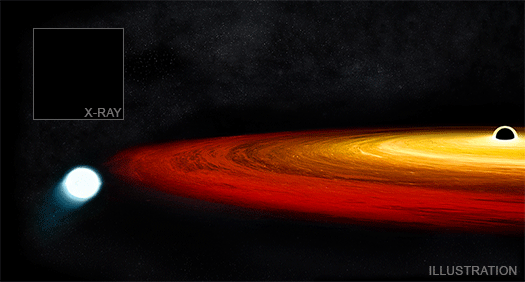Credit: X-ray: NASA/CXO/CSIC-INTA/G.Miniutti et al.; Illustration: NASA/CXC/M. Weiss;
Data from NASA's Chandra X-ray Observatory and ESA's XMM-Newton
indicate that a star survived a close call with a black hole, as
described in our latest press release. As a red giant star approached a supermassive black hole
in the galaxy GSN 069, it was caught in the black hole's gravity. Once
captured, the outer layers of the red giant containing hydrogen were
stripped off and careened toward the black hole, leaving the core of the
star — known as a white dwarf — behind.
The white dwarf is now in a highly elliptical orbit that completes
one cycle about once every 9 hours. As its nearest point in its
oval-shaped path, the white dwarf is no more than 15 times the radius of
the event horizon
— the point of no return — away from the black hole. This artist's
illustration shows the white dwarf (on the left) when it is nearing the
point of closest approach, and is being stretched by the strong gravity
of the black hole (on the far right). The white dwarf should be
travelling at a noticeable fraction of the speed of light at this point.
At closest approach the black hole pulls material from the white dwarf
into an encircling disk. This transfer releases a burst of X-rays that
Chandra and XMM-Newton can detect every 9 hours. The inset is a
time-lapse of Chandra data taken over a period of about 20 hours on
February 14 and 15, 2019, centered on the X-ray source in the middle of
GSN 069. The sequence loops to show that the X-ray brightness of the
source changes regularly and dramatically over the Chandra observation.
The black hole and white dwarf pair should also emit gravitational waves, especially at their nearest point.
Because the white dwarf is so close to the black hole, effects from
the Theory of General Relativity mean that the direction of the orbit's
axis should rotate with time, or "precess", so that multiple orbits make
a rosette-shaped pattern. This rotation should repeat every two days
and may be detectable with sufficiently long observations.
What would be the future of the star and its orbit? The combined
effect of gravitational waves and an increase in the star's size as it
loses mass should cause the orbit to become more circular and grow in
size over time. In this case, the rate of mass loss steadily slows down,
and the white dwarf slowly spirals away from the black hole. About a
trillion years in the future, the white dwarf could lose enough mass to
become a planet with a mass similar to Jupiter.
Astronomers have found many stars that have been completely torn
apart by encounters with black holes (so-called tidal disruption
events), but there are very few reported cases of near misses, where the
star likely survived. Grazing encounters like this should be more
common than direct collisions given the statistics of cosmic traffic
patterns, but they could easily be missed for a couple of reasons.
First, it can take a more massive, surviving star too long to complete
an orbit around a black hole for astronomers to see repeated bursts.
Another issue is that supermassive black holes that are much more
massive than the one in GSN 069 may directly swallow a star rather than
the star falling into orbits where they periodically lose mass. In these
cases, astronomers wouldn't observe anything.
A paper describing these results by Andrew King (University of
Leicester, United Kingdom) appears in the March 2020 issue of the
Monthly Notices of the Royal Astronomical Society, and is available online.
NASA's Marshall Space Flight Center manages the Chandra program. The
Smithsonian Astrophysical Observatory's Chandra X-ray Center controls
science and flight operations from Cambridge and Burlington,
Massachusetts.
What would be the future of the star and its orbit? The combined effect of gravitational waves and an increase in the star's size as it loses mass should cause the orbit to become more circular and grow in size over time. In this case, the rate of mass loss steadily slows down, and the white dwarf slowly spirals away from the black hole. About a trillion years in the future, the white dwarf could lose enough mass to become a planet with a mass similar to Jupiter.
Astronomers have found many stars that have been completely torn apart by encounters with black holes (so-called tidal disruption events), but there are very few reported cases of near misses, where the star likely survived. Grazing encounters like this should be more common than direct collisions given the statistics of cosmic traffic patterns, but they could easily be missed for a couple of reasons. First, it can take a more massive, surviving star too long to complete an orbit around a black hole for astronomers to see repeated bursts. Another issue is that supermassive black holes that are much more massive than the one in GSN 069 may directly swallow a star rather than the star falling into orbits where they periodically lose mass. In these cases, astronomers wouldn't observe anything.
A paper describing these results by Andrew King (University of Leicester, United Kingdom) appears in the March 2020 issue of the Monthly Notices of the Royal Astronomical Society, and is available online. NASA's Marshall Space Flight Center manages the Chandra program. The Smithsonian Astrophysical Observatory's Chandra X-ray Center controls science and flight operations from Cambridge and Burlington, Massachusetts.
Source: NASA’s Chandra X-ray Observatory
Fast Facts for GSN 069:
Scale: X-ray image is about 11 arcsec (13,000 light years) across.
Category: Quasars & Active Galaxies, Black Holes
Coordinates (J2000): RA 1h 19m 08.67s | Dec -34° 11´ 30.1"
Constellation: Sculptor
Observation Date: Feb 14, 2019
Observation Time: 16 hours 33 minutes
Obs. ID: 22096
Instrument: ACIS
References: King, A., 2020, MNRAS, 493, L120; arXiv:2002.00970
Color Code: X-ray: red
Distance Estimate: About 250 million light years

